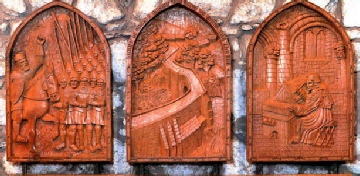








Open to visitors
Monday -
1 April to 31 October 9.30 am to 4.30 pm
1 November to 31 March 10 am to 4 pm
Sunday 2.00pm to 5.00pm
Father of Scots Literature.
His epic poem The Brus is one of a number of poems and romances produced by Barbour, some of which are now lost. His works were amongst the first to be published in Scots, and so he is known as the Father of Scots Literature. Today, those who wish to emphasise the distinctiveness of Scottish cultural identity look to Barbour as the Father of Scots Literature because of his lyrical and passionate nationalism.
The Brus
"A! fredome is a noble thing!
Fredome mayss man to haiff liking;
Fredome all solace to man giffis:
He lyves at ess that frele lyvs! (xii : 203-
The poem is one of the chief sources of information about the life and times of Robert the Bruce, King of Scots and the period of war with England in the time of Edward II. The text implies considerable use of eyewitness accounts of events.
Memorial to Barbour in St Machar's Cathedral
This work, consisting of four engraved wood panels, was commissioned by the Cathedral's Kirk Session and Aberdeen University's Scots Leid Quorum, was created by wood carver, Roland Fraser. It commemorates the achievements of John Barbour.
A contribution of £1650 was made by Aberdeen City Council from its Common Good Fund, which was set up by Bruce.
John Barbour
Father of Scots Literature
John Barbour d. 1395
Father of Scots Literature, author of The Brus a Chronicle of the Wars of Independence and the life of Robert the Bruce, King of Scots.
It is known that by 1357 John Barbour was Archdeacon of Aberdeen (in the Middle Ages the diocesan equivalent of a government Chief Whip, in effect the eyes and ears of the Bishop). Barbour studied at Oxford and in France. His literary style was similar to, though it predated that of, Geoffrey Chaucer. The style was probably inspired by the great romance tales of chivalry from Norman France. His literary accomplishments were recognised in his own lifetime and he was in his latter years in receipt of a crown pension. He is buried in the south aisle of the Cathedral, sometimes known as the Barbour Aisle.

| Office Holders |
| News |
| Church Services |
| Our Vision |
| The Cathedral Community |
| Visitors |
| Find Us |
| Privacy |
| Family History |
| Worship |
| Sunday School |
| Prayer and Meditation |
| Weddings |
| The Choir |
| Bell ringer |
| Concerts |
| Choir Membership |
| Creche |
| Eco-congregation |
| Friends of St Machar |
| Churches by the Don |
| Opportunities to Help |
| Charities |
| Stewardship |
| Links |
| Digital Resources |
| Biodiversity Project |
| School and Group Visits |
| Award |
| Info |
| Dunbar Hall |
| Cathedral Guide |
| Windows |
| The Heraldic Ceiling |
| The Organ |
| Organists of St Machar |
| Bells of St Machar |
| War Memorial |
| Restoration Work |
| Graveyard and Outside |
| The History of the Choir |
| Events at Dunbar Hall |
| Exhibition |
| Shield Names |